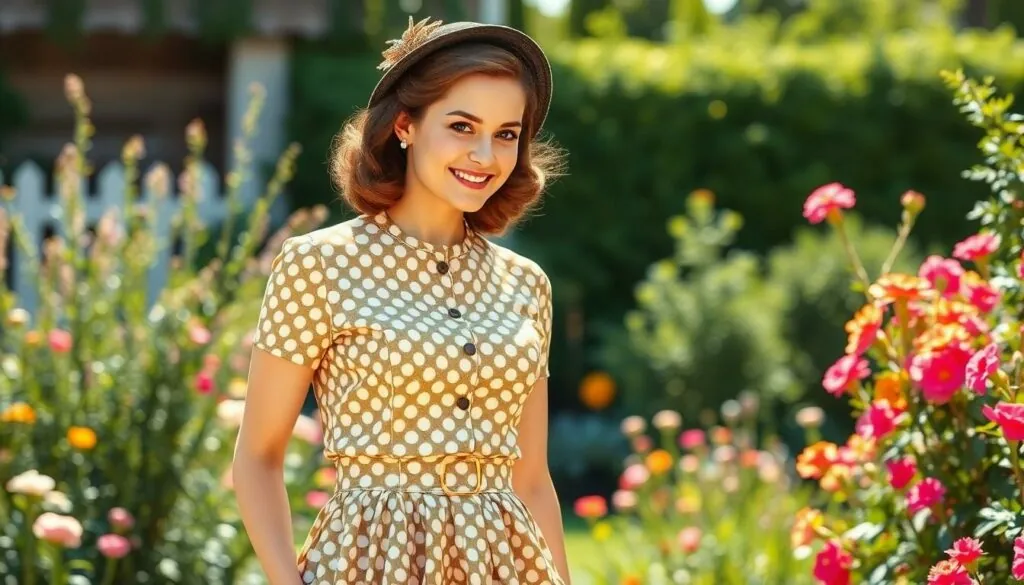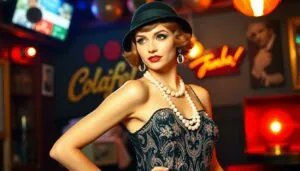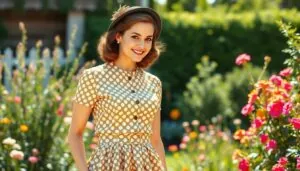Step into a time when women’s fashion was as bold as their spirit. The 1940s were a whirlwind of creativity, practicality, and a touch of glamour, fueled by the challenges of World War II and the post-war optimism that followed. From the iconic silhouettes of wartime utility wear to the flirty dresses that danced into the 50s, women navigated their wardrobes with flair and finesse.
Forget those oversized shoulder pads that could double as a flotation device. The real stars of the decade were the elegant tea dresses, chic skirts, and tailored suits that made every woman feel like she could conquer the world—one stylish step at a time. Join the journey through the fascinating evolution of 1940s women’s fashion, where every hemline told a story and every outfit was a testament to resilience and style.
Table of Contents
ToggleOverview Of 1940’s Women’s Fashion
1940s women’s fashion reflected the era’s complexities and transformations. Wartime influences dictated offerings, focusing on practicality and utility due to limited resources. Fabrics like wool and cotton predominated, while luxurious materials were reserved for special occasions.
Designers embraced structured silhouettes, favoring tailored suits that conveyed professionalism and sophistication. Skirts frequently featured a mid-calf length, allowing ease of movement while maintaining a feminine touch. Women often paired tailored jackets with blouses, combining elegance and functionality.
Tea dresses gained popularity in the post-war period. These dresses designed with floral prints and soft fabrics marked a shift towards romantic styles. Accessories became essential with embellishments like gloves and hats enhancing overall outfits.
Footwear also underwent changes, with sturdy shoes evolving into more fashionable options. Heels became a staple, adding height and charisma to the ensembles. Additionally, the introduction of the wedge heel offered practicality without sacrificing style.
Colors in 1940s fashion varied significantly, from muted tones to bold, vibrant shades. Earthy colors reflected wartime aesthetics, while pastels emerged in post-war collections, mirroring a sense of renewal and optimism.
Significantly, women’s fashion in the 1940s served as a medium for personal expression amidst societal changes. Each outfit symbolized resilience and transformation in response to external circumstances, embodying the spirit of the time.
Key Trends In 1940’s Women’s Fashion

1940s women’s fashion showcased a unique blend of functionality and elegance, reflecting the era’s cultural shifts and societal changes. Key trends emerged, highlighting significant silhouettes, shapes, color palettes, and fabric choices that defined this transformative decade.
Silhouettes And Shapes
Structured silhouettes dominated 1940s fashion. Tailored suits featured sharp shoulders, emphasizing a professional yet feminine look. Mid-calf skirts allowed movement while offering a touch of elegance. Tea dresses emerged in the post-war period, boasting cinched waists and flowing skirts to enhance a romantic appeal. Additionally, the use of peplums added a sophisticated flair to various outfits. Overall, these elements combined to create a distinct fashion identity for women during this pivotal time.
Color Palettes And Fabrics
Color palettes evolved dramatically throughout the 1940s. Initially, muted tones in navy, olive, and grey reflected wartime scarcity. As the decade progressed, vibrant pastels and floral prints became popular, symbolizing post-war optimism. Fabrics included wool and cotton for everyday wear, emphasizing practicality. Luxurious silk and satin emerged for formal occasions, elevating styles while maintaining a sense of modesty. This combination of colors and materials contributed to the era’s unique fashion landscape, celebrating both resilience and renewal.
Iconic Designers Of The Era
The 1940s showcased remarkable designers whose innovations shaped women’s fashion during this transformative decade.
Contribution Of Coco Chanel
Coco Chanel made significant contributions during the 1940s, redefining elegance with her focus on comfort and simplicity. She popularized the concept of the “little black dress,” a timeless staple that emphasized versatility and sophistication. Chanel’s designs often incorporated practical fabrics, reflecting wartime resource constraints while maintaining an air of luxury. She favored streamlined silhouettes with a minimalist approach, moving away from the elaborate styles of previous decades. Accessories like her signature Chanel handbags added to the allure, enhancing the overall look. The combination of functionality and timeless style marked her significant influence during this era.
Influence Of Christian Dior
Christian Dior revolutionized women’s fashion in the late 1940s with his iconic “New Look.” This design aesthetic emphasized an hourglass silhouette, featuring fitted bodices and full skirts that celebrated femininity. Dior’s 1947 collection contrasted sharply with the wartime styles, marking a return to luxury and extravagance. Fabrics such as silk and taffeta enhanced the overall opulence of his creations. His emphasis on detailed tailoring created a sophisticated look that appealed to post-war women eager for glamour. Ultimately, Dior’s impact established a new standard of elegance, influencing designers and shoppers alike for years to come.
Everyday Fashion In The 1940’s
1940s women’s fashion demonstrated a unique interplay between practicality and style, influenced predominantly by wartime needs and post-war revival.
Wartime Effects On Style
Wartime rationing heavily impacted clothing choices. Fabric restrictions meant many women opted for garments made from affordable materials like cotton and wool. As a result, practicality took precedence over extravagance. Dress styles typically included structured silhouettes, which allowed mobility while maintaining a polished look. Tailored suits became iconic, characterized by sharp shoulders, emphasizing professionalism. The enduring popularization of utilitarian styles conveyed a sense of resilience amidst challenges. Evening wear garnered limited luxury, often reserved for special occasions. Women balanced functionality with fashion, expressing their individuality through subtle accessories, as personal flair gained importance during this period.
Casual Wear Trends
Casual wear in the 1940s highlighted comfort and versatility. High-waisted slacks gained popularity, providing an alternative to skirts. Blouses featuring cheerful prints enhanced daily outfits, elevating everyday looks. As the decade progressed, tea dresses emerged, blending femininity with ease. Crafted from lighter fabrics, these dresses showcased floral patterns that symbolized renewal. Accessories like lightweight cardigans added layers of style and warmth. Footwear transitioned from sturdy shoes to chic espadrilles and wedges, integrating fashion with comfort. Casual styles evolved, reflecting women’s growing independence and ability to express their creativity even in their everyday wardrobes.
The 1940s stand as a defining decade in women’s fashion, showcasing a remarkable evolution from wartime utility to post-war glamour. This transformation not only illustrated the resilience of women but also their desire for self-expression through style. The era’s iconic designers left an indelible mark on the fashion landscape, blending practicality with elegance.
As women embraced new silhouettes and vibrant colors, they celebrated their newfound independence and creativity. The trends of this decade continue to inspire contemporary fashion, reminding us of the power of clothing as a form of personal expression. The legacy of 1940s women’s fashion remains a testament to the strength and spirit of women during a time of change.




